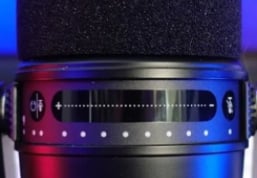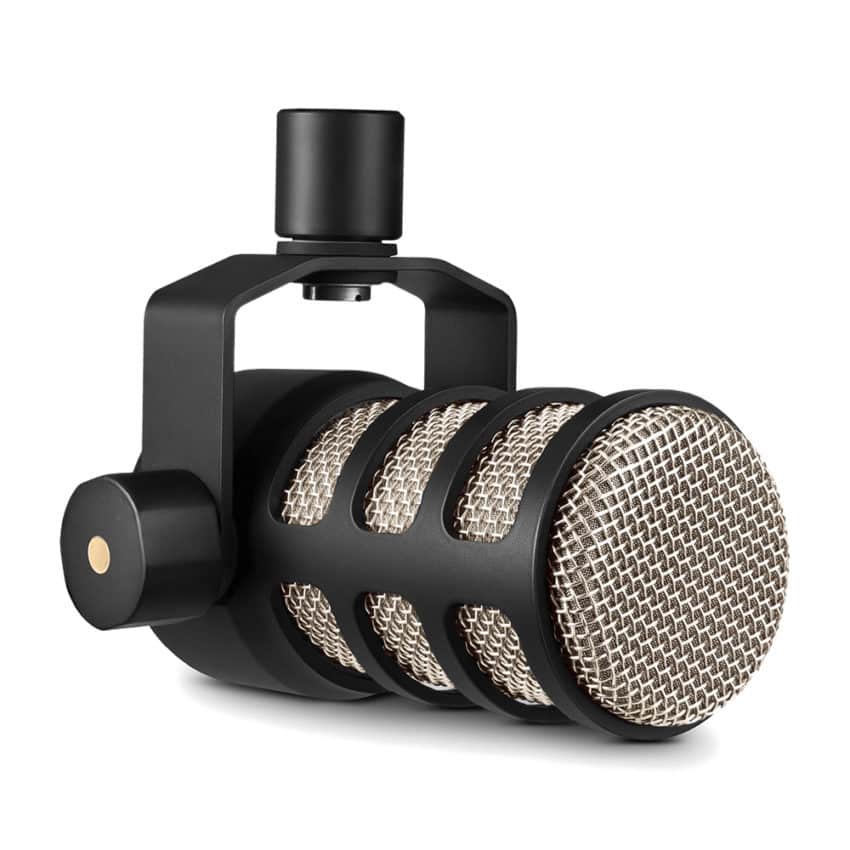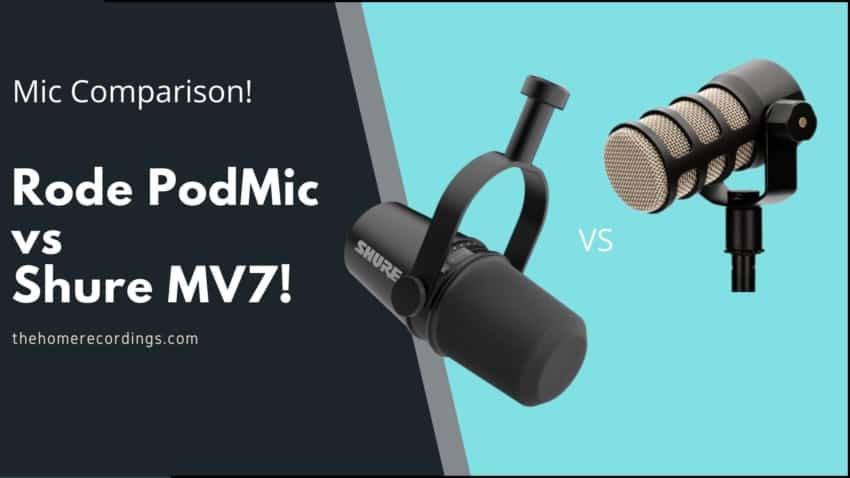Last updated on December 29th, 2023 at 09:52 pm
Both the Shure MV7 and the Rode Podmic have been popular broadcasting microphones since their respective releases, but the Shure is almost three times more expensive. However, is this huge price difference worth it?
In this article, I will be going over their differences, their pros & cons, how they sound, their ease of use, the included software (if they have any), which one I think you should go for depending on if you’re a gamer, streamer, podcaster, or musician, and more.
So, without any further ado, let’s get started!
In short, here are the differences between the Shure MV7 and the Rode PodMic: Both are dynamic microphones with a cardioid polar pattern, but the Shure MV7 offers a USB connection in addition to the XLR one, a touch-sensitive tab to control the mic, and an included software for further process the sound, whereas the Rode only has an XLR connection and no other features.
So, let’s get this show on the road, shall we?
Shure MV7 Overview

The Shure MV7 is a relatively new mic that seems to have been designed to bridge the gap between the more affordable USB microphones and the almighty SM7B, which is the standard podcasting mic that sells for roughly $400.
The Shure MV7 looks very similar to the SM7B and it’s also a dynamic microphone, which is not that common for USB microphones since most of them are condensers, and this means that it generally won’t pick up as much background noise, making it a good choice for anyone who is running a podcast or gaming at home where there might be some noise.
The most important feature of the Shure MV7 is that it not only features a USB connection, but an XLR one as well, and if you read any of my other USB mic-related articles then you probably know that, while I like USB mics and I think that they have their place, they don’t offer an upgrade path and you will end up spending a lot more once you move on to a more professional setup.
With the Shure you can simply buy a Mixer or an Audio Interface and won’t have to worry about not being able to use it since you can simply connect it to the mixer using an XLR cable.

Another distinctive feature is its interactive touch panel on the top which lets you control the audio level, the monitor mix, and you can tap it to mute/unmute the mic and the headphones. While I do think that this is a really modern way of doing things, I don’t know if a touch panel will last longer than knobs, so we’ll have to wait and see.
Lastly, it comes with the ShurePlus MOTIV software which comes with a lot of features that podcasters and gamers are going to enjoy, such as:

- Control the gain automatically or do it manually.
- Change the tone from Dark to Natural or Bright.
- Adjust the monitor mix.
- Adjust the audio “view” of the mic, such as “Near” and “Far”.
- Manual mode lets you adjust the gain, the monitor mix, it offers some basic EQ, a limiter, and a basic compressor.
The EQ and compressor only offer basic settings that you can turn on or off, like High-Pass filter, presence boost, etc., and don’t really give you a more granular control over the signal.
The Limiter is an excellent feature to have, especially for podcasters and gamers, since they prevent loud audio spikes, which could easily jump scare your audience.
What comes in the box?
- Shure MV7 USB/XLR Microphone.
- Micro USB to USB-C cable.
- Micro USB to USB-A cable.
Features
- USB and XLR connections.
- Touch Controls (no knobs).
- Dynamic microphone (better for background noise).
- ShurePlus MOTIV software for better control over the audio signal.
How does it sound?
This mic reminds me a lot of the way the Shure SM7B sounds, especially in the low end since it makes your voice sound deep and really full, which is why I think that it’s especially good for podcasters. Other than that, it sounds really balanced and I don’t think that there’s anything that stands out as “bad”, like no frequencies poking their head out too much.
As far as recording music goes, it actually surprised me quite a lot since recording my acoustic guitar sounded full but not boomy, and the higher end had a nice open airy sound to it. Overall, quite impressed.
One thing that I don’t particularly like, however, is the foam pop filter, especially for being such an expensive microphone, since I feel like it doesn’t really do that much in terms of reducing the plosives. It’s super thick on the sides but the top is extremely thin (hold it up against a light and you can almost see right through it).
I don’t know why they went with this design, maybe a thicker pop filter affected sound quality? I don’t know, but it doesn’t work as well as I would’ve hoped.
So, either offset it when recording (off axis) and see if you like how it sounds, or find a way to put a pop filter in front of it.
Also, it doesn’t come with a built-in shock mount, so taping on the desk, keyboard, or just accidentally bumping against the boom arm/tripod, will transmit all of that vibration into the mic.
Specifications
- Polar Pattern; Cardioid
- Connectivity: XLR and USB
- Frequency Response: 20Hz- 20kHz
- Sample Rate: 44.1/48kHz/16/24-bit
- Max SPL: 132dB
- Weight: 550g
Get the Shure MV7 here.
- Shure MV7: Amazon, Sweetwater.
Rode PodMic

The Rode PodMic is an XLR (no USB port) cardioid dynamic microphone designed specifically for broadcasting, which is also why it looks the way it does and, at least to me, it looks way more professional than many other microphones out there (maybe not as much as the Shure SM7B, though).
It’s got an all-metal body with a metal mesh grille and features a U-bracket for attaching it to the mic stand/boom arm that lets you swivel the microphone by roughly 270-degrees, and despite being a roughly $100 mic, if you take care of it it should last you for a very long time since it’s basically got just one point of failure which would be the XLR connection (Additional USB connections, headphone outputs, knobs, etc., can all contribute to a shorter lifespan).
Also, this microphone is incredibly heavy (almost 2 pounds, or 1Kg) considering its small size, which makes it feel a lot more expensive than other alternatives out there.
Note: Since this is a purely XLR microphone that doesn’t come with a USB output, you’re going to need some sort of interface or Mixer to use it which, if you don’t already own, will drastically increase the price.
Lastly, it does come with a built-in pop filter which sort of works, but for anyone who’s actually serious about preventing plosives, you may need to get an external windscreen. Also, the mounting system it comes with doesn’t have any sort of shock absorption (more on this in a second as well).
There’s not much else to say about the PodMic in terms of general features since it doesn’t really have any. So let’s move on to what comes in the box and how it sounds.
What do you get in the Box?
- Rode PodMic.
Features
- Outstanding built quality.
- Dynamic microphone (good for reducing background noise).
How does it Sound?
I tested this mic on my acoustic and electric guitars, as well as singing and, obviously, spoken word, since that’s what it’s actually designed for.
For spoken word it’s a great microphone since it’s got a bit of a bump around the 150Hz mark, which makes my voice sound fuller and with more body. Of course, this depends on your type of voice as well.
Since it’s got a scooped mid range, I felt like I had to boost that a little when recording my voice, but it wasn’t a bad sound at all and I think most people will be more than fine with that and, if not, you could simply apply some subtle EQ and that’s it!
The really high end is where I thought that this mic was lacking a bit since it’s got a nice boost in the 10kHz range, but then it tapers off dramatically, reducing the overall airiness & openness (and this was also the case when singing and recording all my guitars, I just felt that cut from 12kHz onwards really made everything sound less chimy and open.
For singing purposes, it’s a good mic. I love the way dynamic microphones record vocals and this one did really well. Although the same issue with the high-frequencies made me reach for a shelving EQ and boost those slightly.
The acoustic guitar sounded great, and I think that it’s because of the 150Hz boost since it had a good amount of body to it.
Lastly, the electric guitar: Recording a distorted amp with the PodMic gives you a very scooped sound, making it a pretty solid choice for recording metal guitars, but if you’re more into blues, rock, etc., then I would recommend going with something else.
Specifications
- Polar Pattern: Cardioid
- Frequency Response: 20Hz- 20kHz
- Sensitivity: -57dB
- Weight: 2lbs.
Get the Rode PodMic here: Amazon, Sweetwater.
Differences and which one should you go for?
As far as the differences go, the Rode PodMic is a much more affordable microphone at the expense of not featuring a USB connection or any controls whatsoever, whereas the Shure MV7 offers both USB and XLR connectivity, it comes with a headphone output and is capable of doing zero-latency monitoring, it’s got a touch-sensitive control pad, and it also features the Shure Plus MOTIV app for adding processing and doing a lot of stream-related things.
The Shure MV7 is the better mic, for sure, but I don’t think that it’s worth 2.5x what the Rode since you don’t really need all the onboard controls of the mic if you have an audio interface or a mixer, and the software is also not essential since there are other workarounds.
So, it all comes down to budget and the equipment you already own: If this is your first microphone and you don’t already own an audio interface or a mixer, then the Shure MV7 is the best option, why? Well, because purchasing an audio interface and an XLR cable will set you back at least $100 and you should actually be considering a more expensive interface with more inputs anyway, otherwise going with an XLR mic over one that has USB connectivity would make no sense.
In short: If you have an audio interface or a mixer, then the Rode PodMic offers a much better value, but if you don’t, the the Shure MV7 is the better choice (even though it’s got XLR connectivity as well and sounds slightly better, but I don’t think the difference in price makes it worth it).
Other alternatives
I reviewed a couple USB mics already and there are two that stand out: The ElGato Wave 3 and the Samson G-Track Pro.
The Elgato Wave 3 is a relatively new mic that was designed specifically for gamers since, similar to the Shure in some sense: It comes with included software designed to help you better control the signal (compression, limiter, it lets you manage and mix the level of different audio signals, such as music playing, the stream’s volume, mic volume, etc.).
The ElGato Wave 3 is also much more affordable than the Shure but it doesn’t feature an XLR connection, so if you will never upgrade to a better solution, then this mic may be better for you.
It’s also worth noting that the ElGato Wave 3 is a condenser microphone and that it may pick up slightly more background noise.
The Samson G-Track Pro is an interesting alternative, mainly for guitarists and bassists since it features an instrument jack that lets you record both the microphone signal and the instrument signal to separate tracks, and you can even use it with amp simulation software with very low latency.
Conclusion
I’m genuinely impressed with the Rode PodMic because of it’s low price tag, since it’s almost 1/3 the price of the Shure, and if you already own an audio interface, mixer, or a portable recorder with XLR inputs, then it’s the much more cost-efficient option.
The Shure MV7, however, sounds just slightly better without EQ and it can work both as a USB and XLR mic, making it much more versatile, but I would only recommend getting it if you don’t already own an interface, mixer, etc.

Awesome blog!